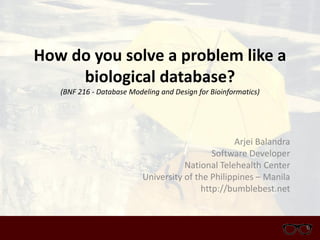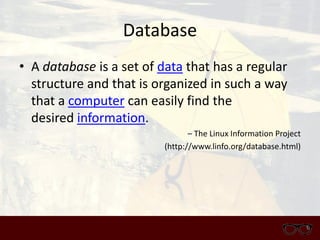Designing Biological Databases
- 1. How do you solve a problem like a biological database? (BNF 216 - Database Modeling and Design for Bioinformatics) Arjei Balandra Software Developer National Telehealth Center University of the Philippines ŌĆō Manila http://bumblebest.net
- 2. Database ŌĆó A database is a set of data that has a regular structure and that is organized in such a way that a computer can easily find the desired information. ŌĆō The Linux Information Project (http://www.linfo.org/database.html)
- 3. Biological Database ŌĆó Biological databases are libraries of life sciences information collected from scientific experiments, published literature, high- throughput experiment technology, and computational analyses. - Wikipedia (en.wikipedia.org/wiki/Biological_database)
- 5. European Nucleotide Archive ŌĆō EMBL-EBI
- 6. DDBJ ŌĆō DNA Data Bank Of Japan
- 7. Why Database? ŌĆó Data-intensive techniques such as high- throughput screening and gene expression experiments demand methods to correlate large and diverse datasets. ŌĆó Databases integrate information from a variety of sources allowing faster and more powerful searches.
- 8. DO A ŌĆ£GOODŌĆØ DATABASE DESIGN Tip #1:
- 9. Good Database Design ŌĆó Provides easy access to previous results. ŌĆó Supports both expert- and machine-guided searches for novel correlations in data.
- 10. Bad Database Design ŌĆó Obfuscates the correlations for which the user is searching ŌĆó makes it difficult for biologists to fit their data into the database or to find previously stored data resulting to user contempt. ŌĆó ŌĆśbrittleŌĆÖ
- 11. LEARN FROM EXISTING LITERATURE Tip #2:
- 12. ŌĆó Generalizations ŌĆó Incorporate existing schema into the database design ŌĆó Use existing structures for common data
- 13. Generalizations
- 15. RESPECT THE UNIQUE NEEDS OF BIOLOGISTS (AND USERS) Tip #3:
- 16. Business rules ŌĆó constraints ŌĆō based on data derived from the real-world entities ŌĆō specific to the needs of the organization.
- 17. What they need? ŌĆō Use free-text Comments ŌĆō Create user-specific categories Dealing with Business Rules
- 19. DESIGN THE DATABASE BEFORE BUILDING IT Tip #4:
- 20. USE THE DATABASE TO ENFORCE DATA INTEGRITY Tip #5:
- 21. Normalization
- 22. Normalization
- 23. Normalization
- 24. KEEP THE DATABASE SCOPE MANAGEABLE Tip #6:
- 25. ŌĆó In Biology, one size does not fit all ŌĆó Focus on a subset of Biology (ie. Genes, Proteins) ŌĆó In large subsets, do it one at a time ŌĆó Inclusive Keep the database scope manageable
- 26. LISTEN TO THE PEOPLE WHO HAVE TO WRITE AND USE THE INTERFACE Tip #7:
- 27. ŌĆó Databases are successful only when people use it Users know what they want and need + Developers know what they can do + Designers know what must be done --------------------------------------------------------- = Collaborative approach to develop a successful database
- 28. TEST THE DESIGN WITH REALISTIC DATA Tip #8:
- 29. MAKE THE DATABASE STRUCTURE UNDERSTANDABLE AND EASY TO MAINTAIN Tip #9:
- 32. References ŌĆó The Linux Information Project (http://www.linfo.org/database.html) ŌĆó Nelson, M.R., Reisinger, S.J., Henry, S. (2003).Designing databases to store biological information. BIOSILICO Vol. 1, No. 4 ŌĆó Wikipedia (en.wikipedia.org/wiki/Biological_database) ŌĆó Lemer, C., Antezana, E., Couche, F., Fays, F., Santolaria, X., Janky, R., ŌĆ” Wodak, S. J. (2004). The aMAZE LightBench: a web interface to a relational database of cellular processes. Nucleic Acids Research, 32(Database issue), D443ŌĆōD448. doi:10.1093/nar/gkh139
































